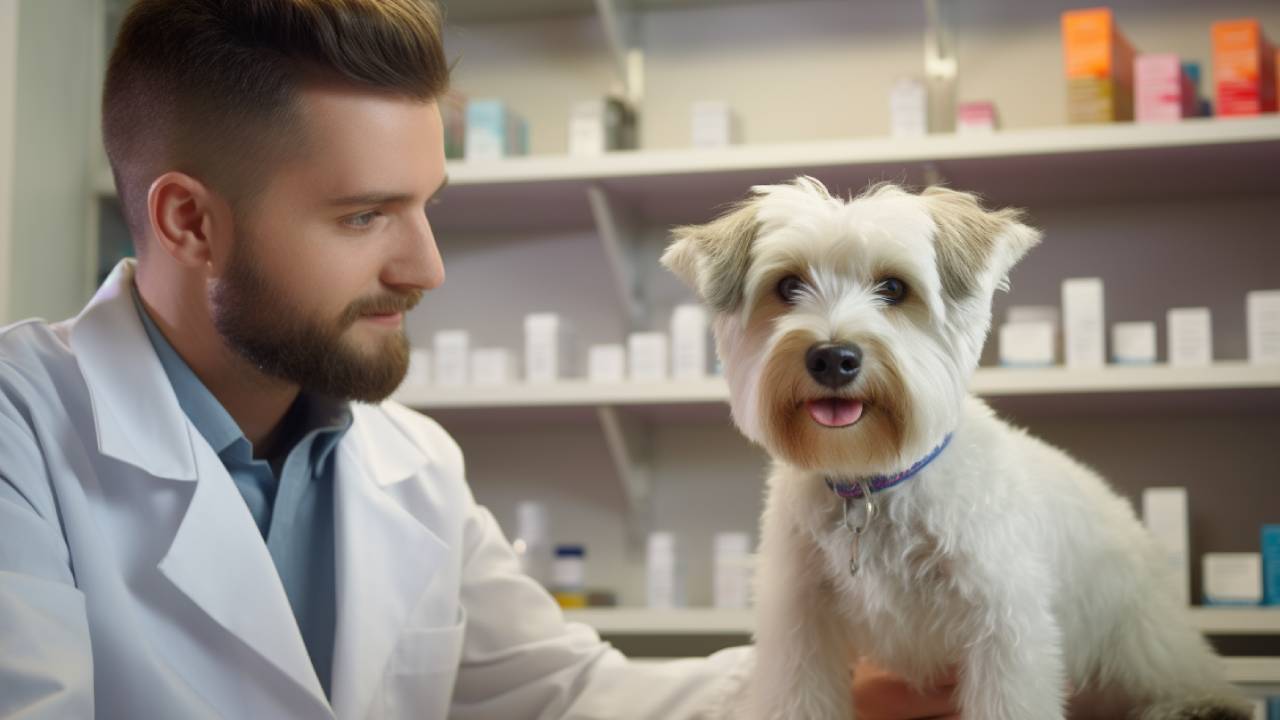Benadryl is a handy remedy for our furry friends’ allergies and travel woes. But how much is too much? This guide on the safe dosing of Benadryl for dogs ensures your pup gets relief without the risk.
Whether you’re a first-time pet owner or a seasoned dog enthusiast, we will equip you with the knowledge to use Benadryl safely for your furry friend, complemented by dog insurance, for peace of mind in managing your pet’s health.
What is Benadryl?
Benadryl is an over-the-counter antihistamine medication commonly used to alleviate various allergy-related symptoms in humans and, in some cases, dogs. Its active ingredient is diphenhydramine, which blocks histamines in the body.
Benadryl is often used in humans to treat hay fever, itching due to insect bites or stings, and common cold symptoms. It can also be a sleep aid due to its soothing effect. Veterinarians sometimes prescribe Benadryl to manage allergies or alleviate symptoms of allergic reactions in dogs.
“Please talk to your doctor before use. Diphenhydramine is used extra-label for treating pruritus, skin disorders, and vestibular disorders, as an antiemetic, and for preventing anaphylaxis in veterinary species. But I would not consider Benadryl a #1 choice for skin allergies. Use with caution in patients with closed-angle glaucoma, prostatic hypertrophy (may exacerbate stranguria), pylori duodenal obstruction, and urinary bladder obstruction.” – Veterinarian Mykhailo Ozmenchuk.
Contraindicated in patients with known hypersensitivity to diphenhydramine and with asthma attacks. Adverse effects include sedation, ataxia, agitation, behavior changes, anorexia, dry mouth, mydriasis, tachycardia, urinary retention, and intestinal atony.
Can Benadryl be Given To a Dog for Allergies or Anxiety?
Yes, Benadryl can be given to dogs; however, it’s crucial to consult your veterinarian first to determine the appropriate dosage and ensure that allergies cause your dog’s discomfort.
For Allergies: Benadryl can be given to dogs to help manage allergy-related symptoms, such as itching, sneezing, and skin irritations. It works by blocking histamines, which are chemicals responsible for allergic reactions.
For Anxiety: In some cases, Benadryl may temporarily alleviate mild anxiety or restlessness in dogs due to environmental stressors, such as thunderstorms or car rides.
It’s best to consult your vet for a more comprehensive anxiety management plan for chronic or severe anxiety issues. This plan may include behavior modification techniques or other medications designed explicitly for anxiety in dogs. Additionally, it’s vital to be aware of other potential household hazards, such as poisonous plants for dogs, to ensure your home environment remains safe for your canine companion.
Is Benadryl Safe for Dogs?
Benadryl can be considered safe for dogs when used under the guidance and supervision of a veterinarian. There are several potential benefits or pros to using Benadryl for dogs in specific situations:
- Allergy Relief: A go-to for mitigating allergic reactions, Benadryl effectively eases symptoms like itching and sneezing that result from exposure to allergens such as pollen, dust, or certain foods.
- Motion Sickness Management: Benadryl’s calming properties benefit dogs suffering from motion sickness, relieving nausea and unease during car rides.
- Critical for Emergency Allergic Reactions: In acute cases of severe allergic reactions marked by swelling, hives, or breathing troubles, Benadryl is a vital temporary measure while seeking urgent veterinary attention.
- Soothing Sedative: Benadryl, by leveraging its sedative effects, helps soothe anxiety, restlessness, and sleep disturbances in dogs caused by environmental stressors, ensuring a more relaxed state.
- Part of a Comprehensive Treatment Plan: Benadryl is invaluable in treating chronic skin issues or allergic dermatitis, addressing itching and inflammation as a component of a holistic care strategy.
When considering Benadryl’s adverse effects, it’s crucial to recognize the signs of potential overmedication. To understand the seriousness, read about Fatal diphenhydramine poisoning in a dog, which underscores the importance of adhering to the correct dosage.
While there are advantages to using Benadryl for dogs, it should always be administered with caution and under the guidance of a veterinarian.

Side Effects of Benadryl for Dogs
While Benadryl is generally safe for dogs when used correctly, pet owners need to be aware of potential side effects that can occur. Here are some common side effects associated with Benadryl use in dogs:
1. Drowsiness: Due to its sedative properties, one of Benadryl’s most common side effects is that it can cause dogs to become sleepy or lethargic.
2. Dry Mouth: Benadryl may reduce saliva production, leading to a drier mouth in dogs. This can manifest as increased thirst.
3. Urinary Retention: Some dogs may experience difficulty urinating or exhibit less frequent urination due to the anticholinergic effects of Benadryl.
4. Hyperactivity: Though less common, some dogs might react to Benadryl by becoming hyperactive or exhibiting increased excitement.
5. Digestive Upset: Benadryl can cause gastrointestinal issues in some dogs, including diarrhea or vomiting.
6. Increased Heart Rate: In some cases, Benadryl may cause an elevated heart rate, which is important to monitor in dogs with pre-existing heart conditions.
Having a vet observe your dog closely after administering Benadryl for the first time can help you quickly identify any adverse reactions. For a deeper understanding, consider reading the Evaluation of diphenhydramine as a sedative for dogs, providing valuable research findings.
Liquid Benadryl Dosage Formula for Dogs
When using liquid Benadryl for dogs, it’s essential to calculate the correct dosage based on your dog’s weight. The general guideline for liquid Benadryl is to administer 0.4 to 1 mg of liquid Benadryl per pound (1 to 2 mg per kilogram) of your dog’s body weight. Here’s a formula to help you calculate Benadryl dosage in milliliters:
- Liquid Benadryl Dosage (mg) = Dog’s Weight (lbs) x 0.4 to 1 mg/lb
For example, if your dog weighs 20 pounds, you can calculate the dosage as follows:
- Dosage = 20 lbs x 0.4 to 1 mg/lb = 8 mg to 20 mg
In this case, you can administer between 8 mg and 20 mg of liquid Benadryl to your 20-pound dog, depending on the severity of their condition, and after consulting your veterinarian for precise dosing instructions.
Benadryl Dosage by Weight Chart
| Your Dog Weight (lb) | Recommended Dosage (mg) | Maximum Dosage (mg) |
|---|---|---|
| 1 to 10 | 5 | 10 |
| 11 to 20 | 10 | 20 |
| 21 to 30 | 15 | 30 |
| 31 to 40 | 20 | 40 |
| 41 to 50 | 25 | 50 |
Please note that these are general guidelines and should not replace the advice of your veterinarian. Always consult your vet to determine the appropriate dosage for your dog’s condition and needs.
Don’t give over-the-counter medications to your pet without professional advice, benadryl can offer relief to dogs suffering from allergies or anxiety, but it must be used with caution and under the supervision of a veterinarian.

FAQs
Can I give my dog Benadryl tablets designed for humans?
Yes, dogs can take human Benadryl tablets. However, it’s crucial to use only plain Benadryl without any added ingredients like pseudoephedrine, xylitol, or alcohol, which can be harmful or even toxic to dogs. Always check the label and consult with your vet before administration.
How quickly does it start working in dogs, and how long does it last?
Benadryl typically begins to take effect within 30 minutes of administration. Its sedative effects can last between 8 to 12 hours. Monitoring your dog during this period is important to ensure they’re comfortable and not experiencing adverse side effects.
Is it safe to give my dog Benadryl daily for allergies?
Some veterinarians may recommend daily use of Benadryl for chronic conditions like allergies. However, long-term use should always be under the guidance of a vet, who can monitor for potential side effects or adjust dosages as needed.
What should I do if I accidentally dose my dog too big?
If you suspect an overdose, it’s critical to seek veterinary care immediately. Symptoms of an overdose may include extreme drowsiness, confusion, rapid heart rate, or seizures. Prompt treatment is essential for the best outcome.
Can I use Benadryl cream on my dog’s skin?
While Benadryl cream may relieve itching or irritation in humans, it’s not recommended for dogs due to the risk of ingestion while grooming. Oral Benadryl is safer and more effective for treating allergic reactions in dogs. Always consult your veterinarian for appropriate skin treatments for your pet.






0 Comments